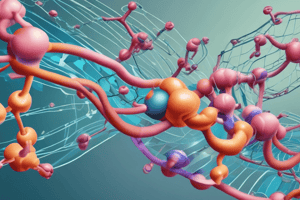Podcast
Questions and Answers
What is the primary component of proteins?
What is the primary component of proteins?
- Polypeptides
- Intermolecular forces
- Peptide linkages
- Amino acids (correct)
What type of protein is responsible for muscle contraction?
What type of protein is responsible for muscle contraction?
- Catalytic proteins
- Regulatory proteins
- Contractile proteins (correct)
- Structural proteins
Which protein consists of a single polypeptide chain?
Which protein consists of a single polypeptide chain?
- Hemoglobin
- Albumin (correct)
- Insulin
- Collagen
What is the term for proteins that contain a protein part and a non-protein part?
What is the term for proteins that contain a protein part and a non-protein part?
What is the function of transport proteins?
What is the function of transport proteins?
What type of protein is involved in the regulation of metabolism?
What type of protein is involved in the regulation of metabolism?
What is the term for proteins that are degradation products of native proteins?
What is the term for proteins that are degradation products of native proteins?
What is the term for proteins that contain only amino acids?
What is the term for proteins that contain only amino acids?
Which class of proteins based on shape are albumin and globulins part of?
Which class of proteins based on shape are albumin and globulins part of?
Which protein classification would casein of milk fall under based on nutritional value?
Which protein classification would casein of milk fall under based on nutritional value?
What type of proteins are deficient in more than one essential amino acid?
What type of proteins are deficient in more than one essential amino acid?
Which protein classification includes collagen and elastin?
Which protein classification includes collagen and elastin?
Which proteins are primarily spherical or oval in shape?
Which proteins are primarily spherical or oval in shape?
What type of protein can be effectively derived from pulses and cereals?
What type of protein can be effectively derived from pulses and cereals?
Study Notes
Protein Structure
- Proteins are macromolecules composed of long chains of amino acids linked by peptide bonds.
- Polypeptides contain additional intermolecular forces, contributing to their structure.
- A protein may consist of one or more polypeptide chains.
Examples of Proteins
- Albumin: Comprises a single polypeptide chain of 585 amino acid residues.
- Insulin: Consists of two polypeptide chains.
- Collagen: Made up of three intertwined polypeptide chains.
- Hemoglobin: Contains four polypeptide chains.
Classification Based on Function
- Catalytic Proteins: Enzymes that catalyze biochemical reactions.
- Structural Proteins: Provide structural support; examples include collagen and elastin.
- Contractile Proteins: Involved in muscle contraction; actin and myosin are key examples.
- Transport Proteins: Carry substances throughout the body; hemoglobin and albumin are notable examples.
- Regulatory Proteins: Regulate metabolism; includes hormones like ACTH and insulin.
- Genetic Proteins: Associated with genetic material; histones exemplify this category.
- Protective Proteins: Function in defense; immunoglobulins serve this purpose.
Classification Based on Composition
- Simple Proteins: Composed solely of amino acids.
- Conjugated Proteins: Contain both protein and non-protein components (prosthetic groups).
- Derived Proteins: Result from the degradation of native proteins.
Classification Based on Composition and Solubility
- Simple Proteins Examples: Albumins and globulins.
- Conjugated Proteins Examples: Include glycoproteins and lipoproteins.
- Derived Proteins: Created from hydrolysis of proteins into peptones, peptides, and amino acids.
Classification Based on Shape
- Globular Proteins: Spherical or oval structures; examples include albumin and globulins.
- Fibrous Proteins: Elongated or needle-like structures; examples include collagen and elastin.
Classification Based on Nutritional Value
- Nutritionally Rich Proteins: Contain all essential amino acids; casein in milk is a prime example.
- Incomplete Proteins: Lack at least one essential amino acid; many plant proteins from pulses are deficient in methionine.
- Poor Proteins: Missing more than one essential amino acid; zein from corn lacks tryptophan and lysine.
Studying That Suits You
Use AI to generate personalized quizzes and flashcards to suit your learning preferences.
Description
Learn about proteins, macromolecules made up of amino acids linked by peptide linkages and intermolecular forces. Understand how polypeptides form proteins, with examples of albumin, insulin, and collagen.




